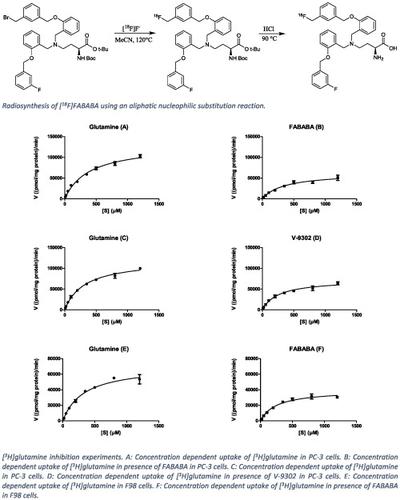当前位置:
X-MOL 学术
›
J. Label. Comp. Radiopharm.
›
论文详情
Our official English website, www.x-mol.net, welcomes your
feedback! (Note: you will need to create a separate account there.)
Radiosynthesis, in vitro and preliminary biological evaluation of [18 F]FABABA, a novel ASCT-2 inhibitor based PET tracer.
Journal of Labelled Compounds and Radiopharmaceuticals ( IF 0.9 ) Pub Date : 2020-07-06 , DOI: 10.1002/jlcr.3863 Tristan Baguet 1 , Jakob Bouton 2 , Jonas Janssens 2 , Glenn Pauwelyn 1 , Jeroen Verhoeven 1 , Benedicte Descamps 3 , Serge Van Calenbergh 2 , Christian Vanhove 3 , Filip De Vos 1
Journal of Labelled Compounds and Radiopharmaceuticals ( IF 0.9 ) Pub Date : 2020-07-06 , DOI: 10.1002/jlcr.3863 Tristan Baguet 1 , Jakob Bouton 2 , Jonas Janssens 2 , Glenn Pauwelyn 1 , Jeroen Verhoeven 1 , Benedicte Descamps 3 , Serge Van Calenbergh 2 , Christian Vanhove 3 , Filip De Vos 1
Affiliation

|
INTRODUCTION
The metabolic alterations in tumors make it possible to visualize the latter by means of positron emission tomography, enabling diagnosis and providing metabolic information. The alanine serine cysteine transporter-2 (ASCT-2) is the main transporter of glutamine and is upregulated in several tumors. Therefore, a good positron emission tracer targeting this transport protein would have substantial value. Hence, the aim of this study is to develop a fluorine-18 labelled version of a V-9302 analogue, one of the most potent inhibitors of ASCT-2. METHODS
The precursor was labelled with fluorine-18 via a nucleophilic substitution of the corresponding benzylic bromide. The cold reference product was subjected to in vitro assays with [3 H]glutamine in a PC-3 and F98 cell line to determine the affinity for both the human and rat alanine serine cysteine transporter-2. To evaluate the tracer potential dynamic μPET images were acquired in a mouse xenograft model for prostate cancer. RESULTS
The tracer could be synthesized with an overall non-decay corrected yield of 3.66 ± 1.90 %. In vitro experiments show inhibitor constants Ki of 90 μM and 125 μM for the PC-3 and F98 cells, respectively. The experiments in the PC-3 xenograft demonstrate a low uptake in the tumor tissue. CONCLUSIONS
We have successfully synthesized the radiotracer [18 F]2-amino-4-((2-((3-fluorobenzyl)oxy)benzyl)(2-((3-(fluoromethyl)benzyl)oxy)benzyl)amino)butanoic acid. In vitro experiments show a good affinity for both the human and rat ASCT-2. However, the tracer suffers from poor in vivo tumor uptake in the PC-3 model. Briefly, we present the first fluorine-18 labelled derivative of compound V-9302, a promising novel ASCT-2 blocker used for inhibition of tumor growth.
中文翻译:

[18 F]FABABA(一种基于 PET 示踪剂的新型 ASCT-2 抑制剂)的放射合成、体外和初步生物学评价。
引言肿瘤的代谢变化使得通过正电子发射断层扫描使肿瘤可视化成为可能,从而实现诊断并提供代谢信息。丙氨酸丝氨酸半胱氨酸转运蛋白 2 (ASCT-2) 是谷氨酰胺的主要转运蛋白,在多种肿瘤中表达上调。因此,针对这种转运蛋白的良好正电子发射示踪剂将具有重大价值。因此,本研究的目的是开发 V-9302 类似物的氟 18 标记版本,它是 ASCT-2 最有效的抑制剂之一。方法 通过相应的溴化苄的亲核取代,用 18 氟标记前体。在 PC-3 和 F98 细胞系中对冷参比产品进行 [3 H]谷氨酰胺体外测定,以确定对人和大鼠丙氨酸丝氨酸半胱氨酸转运蛋白 2 的亲和力。为了评估示踪剂的潜力,在前列腺癌小鼠异种移植模型中采集了动态 μPET 图像。结果 合成示踪剂的总体非衰变校正产率为 3.66 ± 1.90 %。体外实验显示 PC-3 和 F98 细胞的抑制剂常数 Ki 分别为 90 μM 和 125 μM。 PC-3 异种移植物中的实验表明肿瘤组织的摄取较低。结论我们成功合成了放射性示踪剂[18F]2-氨基-4-((2-((3-氟苄基)氧基)苯甲基)(2-((3-(氟甲基)苯甲基)氧基)苯甲基)氨基)丁酸酸。体外实验显示对人和大鼠 ASCT-2 均具有良好的亲和力。然而,该示踪剂在 PC-3 模型中的体内肿瘤摄取较差。简而言之,我们提出了化合物 V-9302 的第一个氟 18 标记衍生物,这是一种有前景的新型 ASCT-2 阻断剂,用于抑制肿瘤生长。
更新日期:2020-07-06
中文翻译:

[18 F]FABABA(一种基于 PET 示踪剂的新型 ASCT-2 抑制剂)的放射合成、体外和初步生物学评价。
引言肿瘤的代谢变化使得通过正电子发射断层扫描使肿瘤可视化成为可能,从而实现诊断并提供代谢信息。丙氨酸丝氨酸半胱氨酸转运蛋白 2 (ASCT-2) 是谷氨酰胺的主要转运蛋白,在多种肿瘤中表达上调。因此,针对这种转运蛋白的良好正电子发射示踪剂将具有重大价值。因此,本研究的目的是开发 V-9302 类似物的氟 18 标记版本,它是 ASCT-2 最有效的抑制剂之一。方法 通过相应的溴化苄的亲核取代,用 18 氟标记前体。在 PC-3 和 F98 细胞系中对冷参比产品进行 [3 H]谷氨酰胺体外测定,以确定对人和大鼠丙氨酸丝氨酸半胱氨酸转运蛋白 2 的亲和力。为了评估示踪剂的潜力,在前列腺癌小鼠异种移植模型中采集了动态 μPET 图像。结果 合成示踪剂的总体非衰变校正产率为 3.66 ± 1.90 %。体外实验显示 PC-3 和 F98 细胞的抑制剂常数 Ki 分别为 90 μM 和 125 μM。 PC-3 异种移植物中的实验表明肿瘤组织的摄取较低。结论我们成功合成了放射性示踪剂[18F]2-氨基-4-((2-((3-氟苄基)氧基)苯甲基)(2-((3-(氟甲基)苯甲基)氧基)苯甲基)氨基)丁酸酸。体外实验显示对人和大鼠 ASCT-2 均具有良好的亲和力。然而,该示踪剂在 PC-3 模型中的体内肿瘤摄取较差。简而言之,我们提出了化合物 V-9302 的第一个氟 18 标记衍生物,这是一种有前景的新型 ASCT-2 阻断剂,用于抑制肿瘤生长。











































 京公网安备 11010802027423号
京公网安备 11010802027423号